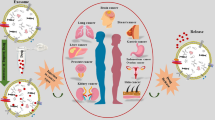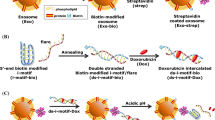Abstract
Anticancer drugs, including doxorubicin (DOX), have been widely used for cancer treatment, but these chemotherapeutic drugs have some issues to address because of their associated side effects, such as cytotoxicity. Various synthetic delivery vehicles for anticancer drugs have been developed to encapsulate and transfer them to cancer cells. However, these delivery vehicles also have high cytotoxicity and immunogenicity. Recently, exosomes have been highlighted as candidates for anticancer drug delivery vehicles with fewer side effects. Exosomes are nanosized particles that are produced from cells, and high concentrations of exosomes are already present in the human body. To develop exosome-based anticancer therapeutics, high drug concentrations should be loaded into exosomes. In this context, phenylboronic acid (PBA) was introduced and chemically conjugated to the exosome surface to load DOX to exosomes. Consequently, a high amount of DOX was efficiently loaded onto the PBA-conjugated exosomes. The DOX-loaded PBA-conjugated exosomes were applied to MDA-MB-231 breast cancer cells and showed enhanced cancer cell cytotoxicity compared to free DOX and DOX-loaded non-conjugated exosomes. Therefore, using PBA-conjugated exosomes for delivering DOX to cancer cells can be a promising strategy for effectively killing cancer cells because a high amount of DOX can be loaded and delivered.
Similar content being viewed by others
References
Liu, Z., A. C. Fan, K. Rakhra, S. Sherlock, A. Goodwin, X. Chen, Q. Yang, D. W. Felsher, and H. Dai (2009) Supramolecular stacking of doxorubicin on carbon nanotubes for in vivo cancer therapy. Angew. Chem. Int. Ed. Engl. 48: 7668–7672.
Takemura, G. and H. Fujiwara (2007) Doxorubicin-induced cardiomyopathy from the cardiotoxic mechanisms to management. Prog. Cardiovasc. Dis. 49: 330–352.
Davis, M. E., Z. G. Chen, and D. M. Shin (2008) Nanoparticle therapeutics: an emerging treatment modality for cancer. Nat. Rev. Drug Discov. 7: 771–782.
Peer, D., J. M. Karp, S. Hong, O. C. Farokhzad, R. Margalit, and R. Langer (2007) Nanocarriers as an emerging platform for cancer therapy. Nat. Nanotechnol. 2: 751–760.
Tahover, E., Y. P. Patil, and A. A. Gabizon (2015) Emerging delivery systems to reduce doxorubicin cardiotoxicity and improve therapeutic index: focus on liposomes. Anticancer Drugs. 26: 241–258.
Kirtane, A. R., R. Langer, and G. Traverso (2016) Past, present, and future drug delivery systems for antiretrovirals. J. Pharm. Sci. 105: 3471–3482.
Omolo, C. A., R. S. Kalhapure, M. Jadhav, S. Rambharose, C. Mocktar, V. M. K. Ndesendo, and T. Govender (2016) Pegylated oleic acid: A promising amphiphilic polymer for nano-antibiotic delivery. Eur. J. Pharm. Biopharm. 112: 96–108.
Yang, X., J. Tong, L. Guo, Z. Qian, Q. Chen, R. Qi, and Y. Qiu (2017) Bundling potent natural toxin cantharidin within platinum (IV) prodrugs for liposome drug delivery and effective malignant neuroblastoma treatment. Nanomedicine. 13: 287–296.
Ying, M., C. Zhan, S. Wang, B. Yao, X. Hu, X. Song, M. Zhang, X. Wei, Y. Xiong, and W. Lu (2016) Liposome-based systemic glioma-targeted drug delivery enabled by all-d peptides. ACS Appl. Mater. Interfaces. 8: 29977–29985.
Lane, R. E., D. Korbie, W. Anderson, R. Vaidyanathan, and M. Trau (2015) Analysis of exosome purification methods using a model liposome system and tunable-resistive pulse sensing. Sci. Rep. 5: 7639.
Schageman, J., E. Zeringer, M. Li, T. Barta, K. Lea, J. Gu, S. Magdaleno, R. Setterquist, and A. V. Vlassov (2013) The complete exosome workflow solution: from isolation to characterization of RNA Cargo. Biomed. Res. Int. 2013: 253957.
Dragovic, R. A., C. Gardiner, A. S. Brooks, D. S. Tannetta, D. J. P. Ferguson, P. Hole, B. Carr, C. W. G. Redman, A. L. Harris, P. J. Dobson, P. Harrison, and I. L. Sargent (2011) Sizing and phenotyping of cellular vesicles using nanoparticle tracking analysis. Nanomedicine. 7: 780–788.
Cho, S., H. C. Yang, and W. J. Rhee (2019) Simultaneous multiplexed detection of exosomal microRNAs and surface proteins for prostate cancer diagnosis. Biosens. Bioelectron. 146: 111749.
Lee, J. H., J. A. Kim, S. Jeong, and W. J. Rhee (2016) Simultaneous and multiplexed detection of exosome microRNAs using molecular beacons. Biosens. Bioelectron. 86: 202–210.
Lee, J. H., J. A. Kim, M. H. Kwon, J. Y. Kang, and W. J. Rhee (2015) In situ single step detection of exosome microRNA using molecular beacon. Biomaterials. 54: 116–125.
Patil, A. A. and W. J. Rhee (2019) Exosomes: biogenesis, composition, functions, and their role in pre-metastatic niche formation. Biotechnol. Bioprocess Eng. 24: 689–701.
Jeong, K., S. Jeong, J. A. Kim, and W. J. Rhee (2019) Exosome-based antisense locked nucleic acid delivery for inhibition of type II collagen degradation in chondrocyte. J. Ind. Eng. Chem. 74: 126–135.
Han, S. and W. J. Rhee (2018) Inhibition of apoptosis using exosomes in Chinese hamster ovary cell culture. Biotechnol. Bioengin. 115: 1331–1339.
Kim, Y. G., U. Park, B. J. Park, K. Kim (2019) Exosome-mediated bidirectional signaling between mesenchymal stem cells and chondrocytes for enhanced chondrogenesis. Biotechnol. Bioprocess Eng. 24: 734–744.
Kim, H. and W. J. Rhee (2020) Exosome-mediated let7c-5p delivery for breast cancer therapeutic development. Biotechnol. Bioprocess Eng. 25: 513–520.
Yang, T., P. Martin, B. Fogarty, A. Brown, K. Schurman, R. Phipps, V. P. Yin, P. Lockman, and S. Bai (2015) Exosome delivered anticancer drugs across the blood-brain barrier for brain cancer therapy in Danio rerio. Pharm. Res. 32: 2003–2014.
Lai, R. C., R. W. Y. Yeo, K. H. Tan, and S. K. Lim (2013) Exosomes for drug delivery — a novel application for the mesenchymal stem cell. Biotechnol. Adv. 31: 543–551.
Schindler, C., A. Collinson, C. Matthews, A. Pointon, L. Jenkinson, R. R. Minter, T. J. Vaughan, and N. J. Tigue (2019) Exosomal delivery of doxorubicin enables rapid cell entry and enhanced in vitro potency. PLoS One. 14: e0214545.
Zhang, J., X. Wang, J. Wen, X. Su, L. Weng, C. Wang, Y. Tian, Y. Zhang, J. Tao, P. Xu, G. Lu, Z. Teng, and L. Wang (2019) Size effect of mesoporous organosilica nanoparticles on tumor penetration and accumulation. Biomater. Sci. 7: 4790–4799.
Andersen, K. A., T. P. Smith, J. E. Lomax, and R. T. Raines (2016) Boronic acid for the traceless delivery of proteins into cells. ACS Chem. Biol. 11: 319–323.
Wang, X., H. Tang, C. Wang, J. Zhang, W. Wu, and X. Jiang (2016) Phenylboronic acid-mediated tumor targeting of chitosan nanoparticles. Theranostics. 6: 1378–1392.
Lee, J., J. Kim, Y. M. Lee, D. Park, S. Im, E. H. Song, H. Park, and W. J. Kim (2017) Self-assembled nanocomplex between polymerized phenylboronic acid and doxorubicin for efficient tumor-targeted chemotherapy. Acta Pharmacol. Sin. 38: 848–858.
Luo, C. Q., L. Xing, P. F. Cui, J. B. Qiao, Y. J. He, B. A. Chen, L. Jin, and H. L. Jiang (2017) Curcumin-coordinated nanoparticles with improved stability for reactive oxygen species-responsive drug delivery in lung cancer therapy. Int. J. Nanomedicine. 12: 855–869.
Lee, J. Y., S. J. Chung, H. J. Cho, and D. D. Kim (2015) Phenylboronic acid-decorated chondroitin sulfate A-based theranostic nanoparticles for enhanced tumor targeting and penetration. Adv. Funct. Mater. 25: 3705–3717.
Toffoli, G., M. Hadla, G. Corona, I. Caligiuri, S. Palazzolo, S. Semeraro, A. Gamini, V. Canzonieri, and F. Rizzolio (2015) Exosomal doxorubicin reduces the cardiac toxicity of doxorubicin. Nanomedicine. 10: 2963–2971.
Hadla, M., S. Palazzolo, G. Corona, I. Caligiuri, V. Canzonieri, G. Toffoli, and F. Rizzolio (2016) Exosomes increase the therapeutic index of doxorubicin in breast and ovarian cancer mouse models. Nanomedicine. 11: 2431–2441.
Otsuka, H., E. Uchimura, H. Koshino, T. Okano, and K. Kataoka (2003) Anomalous binding profile of phenylboronic acid with N-acetylneuraminic acid (Neu5Ac) in aqueous solution with varying pH. J. Am. Chem. Soc. 125: 3493–3502.
Deshayes, S., H. Cabral, T. Ishii, Y. Miura, S. Kobayashi, T. Yamashita, A. Matsumoto, Y. Miyahara, N. Nishiyama, and K. Kataoka (2013) Phenylboronic acid-installed polymeric micelles for targeting sialylated epitopes in solid tumors. J. Am. Chem. Soc. 135: 15501–15507.
Acknowledgements
This work was supported by the Incheon National University Research Grant in 2017.
The authors declare no conflict of interest.
Neither ethical approval nor informed consent was required for this study.
Author information
Authors and Affiliations
Corresponding author
Additional information
Publisher’s Note Springer Nature remains neutral with regard to jurisdictional claims in published maps and institutional affiliations.
Rights and permissions
About this article
Cite this article
Kim, H., Kang, S.J. & Rhee, W.J. Phenylboronic Acid-conjugated Exosomes for Enhanced Anticancer Therapeutic Effect by Increasing Doxorubicin Loading Efficiency. Biotechnol Bioproc E 26, 78–85 (2021). https://doi.org/10.1007/s12257-020-0107-5
Received:
Revised:
Accepted:
Published:
Issue Date:
DOI: https://doi.org/10.1007/s12257-020-0107-5




